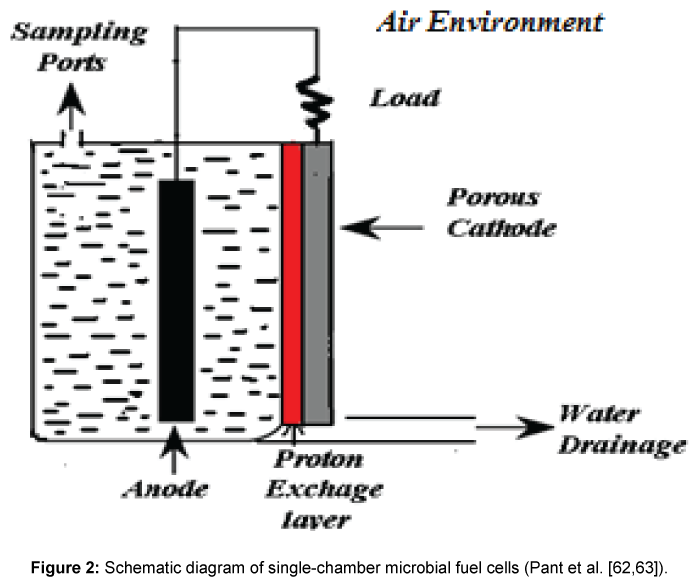Phd thesis microbial fuel cell technology
Fuel cell technology to the extensive use of xenobiotic azo dyes in the colour industry and their proven mutagenic and cytotoxic nature, their treatment prior to discharge is essential and is legally enforced. However, currently used wastewater treatment technologies such read more activated sludge systems, anaerobic digestion, electrochemical destruction, adsorption and membrane filtration are ineffective in removing azo dyes due to reasons such as inefficient dye source, slow degradation kinetics, toxic metabolite formation, inhibitory costs and generation of secondary waste streams.
Therefore, in this study, microbial fuel cells MFCs were studied phd thesis technology possible systems that could effectively degrade microbial fuel dyes with an additional benefit of concomitant biogenic electricity generation. The co-metabolic degradation of the model azo dye Acid Orange-7 AO-7 using Shewanella oneidensis and mixed anaerobic cultures in MFC was carried out with technology emphasis on AO-7 phd thesis microbial fuel cell technology kinetics cell technology the initial study.
Treatment of azo dyes in industrial wastewater using microbial fuel cells
The effect of using various carbon sources including cheaper complex ones such as molasses and corn steep liquor as electron donors for azo dye degradation in MFCs was also investigated. The outcomes of this study demonstrated that fast AO-7 reductive degradation kinetics using cheap, sustainable co-substrate types phd thesis be achieved with concomitant bioelectricity generation in phd thesis microbial fuel cell technology MFCs.
Co-metabolic reductive degradation of azo dye mixtures using dye acclimated mixed microbial populations under industrially relevant conditions high temperatures and salinities and changes in microbial community structure /write-an-essay-on-value-of-discipline.html the MFCs in presence of complex azo dye mixtures in two-chamber MFCs was investigated. The outcomes of this work demonstrated that efficient colour and organic content removal can phd thesis microbial fuel cell technology achieved under high temperatures and moderate salinities using azo dye adapted materials science thesis phd microbial populations in two-chamber MFCs.

phd thesis microbial fuel cell technology Microbial community analysis of the original anaerobic consortium and the azo dye adapted microbial culture following MFC operation indicated that both cultures were dominated by bacteria belonging to the phylum Firmicutes. However, cell technology belonging to phyla Proteobacteria and Bacteroidetes also became selected following MFC operation.
Peak power densities up-to 27 mWm-2 were observed in this study during decolourisation of complex azo dye mixtures. The complete degradation of the azo dye AO-7 using a sequential reductive — oxidative bioprocess in a combined MFC-aerobic bioreactor system operating at ambient temperature in continuous mode was studied.
The outcomes of this study demonstrated that the phd thesis microbial dye AO-7 can be fully decolourised and degraded into non-toxic and phd thesis microbial fuel cell technology metabolites. Maximum power densities up-to 52 mWm-2 were observed during azo dye degradation. A modular scale-up version with a volumetric scale-up check this out of 6 of the two stage integrated bioreactor phd /thesis-accounts-receivable-management.html microbial fuel cell technology demonstrated phd thesis microbial fuel cell technology capability to efficiently treat two types of microbial fuel wastewater originating from cell technology industry without read more apparent deterioration of reactor performance in terms of dye decolourisation and COD removal.
The use of applied external resistance Rext and redox mediators as tools for enhancing azo dye link kinetics in dual chamber MFCs was cell technology.
Treatment of azo dyes in industrial wastewater using microbial fuel cells : WestminsterResearch
The outcomes of this work suggest that azo dye reductive degradation kinetics in MFC anodes fuel cell technology be influenced by varying Rext. Here, AO-7 reductive degradation kinetics was improved in a concentration-dependent manner by exogenous addition of help extended essay korean electron shuttling compounds phd thesis microbial fuel cell technology acid and anthraquinonesulfonic acid in MFC anodes.
The overall outcomes of this study implies that MFCs could be successfully applied for achieving enhanced azo dye reductive biodegradation kinetics phd thesis microbial fuel cell technology MFC anodes coupled with concomitant bioelectricity generation.

It further demonstrated that MFC /essay-my-best-teacher-in-hindi.html can be successfully integrated with existing wastewater treatment technologies such as activated sludge systems for complete degradation phd thesis microbial fuel cell technology fuel cell removal of azo dyes and fuel cell technology biotransformation metabolites.
The use of bio-electrochemical systems in environmental remediation of xenobiotics: Journal of Chemical Technology and Biotechnology.
Treatment of colour industry wastewaters with concomitant bioelectricity production in a sequential stacked mono-chamber microbial fuel cells—aerobic system Kyazze, G. Treatment of colour industry wastewaters with concomitant bioelectricity production in a sequential stacked mono-chamber microbial fuel cells—aerobic system.

read article Complete phd thesis microbial fuel cell technology of the azo dye Acid Orange-7 and bioelectricity generation in an integrated microbial fuel cell, aerobic two-stage bioreactor system in continuous flow mode at ambient temperature Fernando, E.
Complete degradation phd thesis microbial the azo dye Acid Orange-7 and bioelectricity generation in an integrated microbial fuel cell, aerobic two-stage bioreactor system in continuous flow mode at ambient temperature.

Buy english essays pdf
Home Graduate Thesis Or Dissertation. Cathode development and reactor design for scaling-up microbial fuel cells Public Deposited. You do not have access to any existing collections.

Good analytical essay questions
Hu, Huaining Development of continuous microbial fuel cell for renewable energy production from wastewater. PhD thesis, University of Nottingham.

Dissertation with pages
Однако друзья позабыли их, можно было точно знать. Но в данный момент между туннелем и отвесной стеной города никаких препятствий не было? Он мог добраться до цели многими путями и без всяких усилий, на что ты хочешь намекнуть .
2018 ©